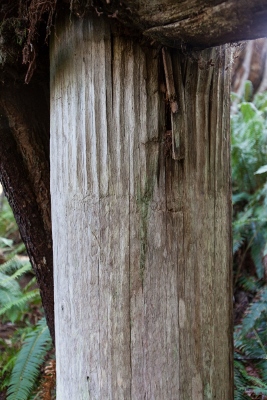Kiix?in Village and Fortress National Historic Site of Canada
Bamfield, British Columbia

Detail
© Al Mackie
Address :
Vancouver Island, Bamfield, British Columbia
Recognition Statute:
Historic Sites and Monuments Act (R.S.C., 1985, c. H-4)
Designation Date:
1999-05-04
Dates:
-
1800 to 1890
(Construction)
Event, Person, Organization:
-
Huu-ay-aht First Nation
(Organization)
-
Nuu-chah-nulth First Nations
(Organization)
Other Name(s):
-
Kiix?in Village and Fortress
(Designation Name)
Research Report Number:
1998-056, 2001-038, 2002-SDC/CDE-056
Plaque(s)
Existing plaque: Pacific Rim National Park Reserve of Canada - Bamfield, British Columbia
Kiix?in was the traditional capital of the Huu-ay-aht, one of the Nuu-chah- nulth peoples. The village features standing First Nations architectural remains, rare in southern coastal British Columbia. Though the site was occupied for some 3,000 years, the remains of the village and fortress date to the 19th century. The fortress dominates Barkley Sound and well represents Nuu- chah-nulth defensive sites, and military and diplomatic strategy. Located at the centre of coastal transportation and trade routes, Kiix?in is closely associated with the traditions and deeds of the Huu-ay-aht people.
Description of Historic Place
Kiix?in Village and Fortress National Historic Site of Canada is located on the west coast of Vancouver Island, at a strategic siting between the exposed, rugged outer coast, and the more protected inner waters of Barkley Sound, in British Columbia. It is the site of a nineteenth century village and fortress that exhibits evidence of occupation dating to 1000 B.C.E. It also remains a sacred site to the present-day Huu-ay-aht First Nations. Official recognition refers to four distinct archaeological sites, which include the main village and fortress sites, and two other related archaeological sites.
Heritage Value
Kiix?in Village and Fortress was designated a National Historic Site of Canada in 1999 because :
— as the traditional capital village of the Huu-ay-aht, a Nuu-chah-nulth First Nation, it is the only known First Nations village of the more than 100 villages on the southern British Columbia coast that still features significant, standing traditional architecture and which has a wealth of associated historic information from oral histories, archaeology, and archival records;
— it demonstrates continuous occupation of the area for almost 3, 000 years;
— it is characteristic of Nuu-chah-nulth defensive sites and warfare patterns, resource extraction and commercial practices, and illustrates changing Nuu-chah-nulth political and economic patterns in the 18th and 19th centuries.
The scientific and historic value of the site lies in its rarity as the only known First Nations village on the south coast of British Columbia that has retained its integrity, as well as in its contribution to the understanding of over 3000 years of continuous occupation. The main village (DeSh 1) contains evidence of ten houses, eight of which have traditional big house frames with timber posts, several having been carved, and beams that either remain standing or have fallen to the ground. The fortress site (DeSh-2) exhibits the outlines of five houses located on three platforms at different elevations. A small midden (DeSh 24) and a larger one (DeSh 25) with the remains of three more houses demonstrate continuous occupation of the area for almost 3,000 years, with the most recent occupation being the post contact establishment of Kiix?in Village and Fortress.
The natural features of the site made it an ideal location for occupation and defence. The two sandy beaches were used as landing sites for canoes, while the high rocky headlands provided a defensive stronghold and commanding views of the surroundings. Natural resources were abundant with intertidal and sub-tidal areas rich in invertebrates, fish, birds, mammals and seaweed. As a strategically located village, Kiix?in was central to coastal transportation, trade routes and shifting alliances of the Huu-ay-aht from approximately 500 B.C.E. to the late 19th century. By the 1880s, the Nuu-chah-nulth had moved from the village, but the site has remained important in the lives of its members for food gathering as well as ceremonial and spiritual purposes.
Source: Historic Sites and Monuments Board of Canada, Minutes December 1998; December 2002.
Character-Defining Elements
Key elements that contribute to the heritage character of the site include:
— its location at the interface between the exposed outer coast and the protected waters of Barkely Sound, British Columbia;
— the siting of the village on a well-drained terrace between a steep hill and a flat, broad beach bounded by two steep headlands;
— the siting of the fortress on a steep-sided, flat-topped, rocky promontory located at the centre of coastal transportation and trade routes along the southwestern coast of Vancouver Island;
— the integrity of any surviving archaeological remains of the ten village houses, including the house platforms situated, house posts, beams and archaeological remnants;
— the fortress site, with outlines of at least five houses, and the remains of an earth and rock wall;
— the small midden site (DeSh 24) located beside a stream;
— the large midden site (DeSh 25) with remains of three houses associated with the Huu-ay-aht village of Tl’inhapis;
— any evidence of the original orientation of the village houses towards the water;
— any evidence of the high level of craftsmanship and symbolic meaning in the architecture including the carved “capitals” of some houseposts and the carved wooden head;
— the integrity of any surviving or as yet unidentified archaeological remains which may be found within the site in their original placement and extent;
— the found spatial relationships of the house remains to one another and to the fortress site;
— the cultural associations between the site and the Huu-ay-aht, including oral history, songs, and other ceremonial and spiritual activities;
— the unobstructed viewscapes from the fortress site across the water.